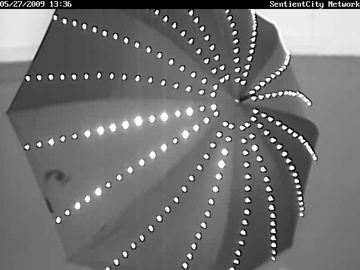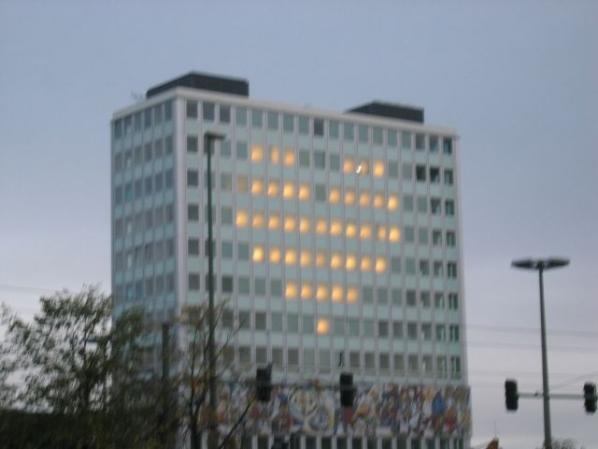



Featured image: Kilmainham Gaol, Dublin, Ireland (Image Credit: Laura Forlano, July 2012)
He looks around to make sure no one is watching him and sets the phone down next to the boxes of cheese. The little silver telephone fits the spot strangely well. It looks as though it has always been sitting there. Having left Shirakawa’s hand, it is now part of the 7-Eleven. –Haruki Murakami, After Dark
Murakami’s novel After Dark (2007) which refers to both the mobile phone as well as the retail environment of the 7-Eleven seems a fitting place to begin a review of a new media art project that uses communication technology to explore and inhabit the space of shopping malls. Digital technologies have enabled the emergence of new forms of participatory art, design and creative practices that inhabit urban, communal and personal spaces in a variety of interesting ways. In June 2012, as part of the Midsummer Festival in Cork, Ireland, the German group Ligna, which consists of media theorists and radio artists, created a radio ballet entitled The First International of Shopping Malls. The ballet was part of a series of events called Parallel Cities that was curated by Lola Arias and Stefan Kaegi.
The First International of Shopping Malls builds on over a decade of new media art that has transformed and appropriated city spaces. For example, in 2003, the Chaos Computer Club’s Project Blinkenlights took, as its canvas, the façade of the former East German Department of Education in order to create a massive urban game board and visual display by programming the lights in each of the windows. Similarly, at the neighborhood level, in 2011, Timo Arnal created, Immaterials: Light Painting WiFi, a project that used Arduino-boards equipped with sensors to illustrate the shape of wireless networks on the streets of Oslo. Finally, at the level of the body, Mark Shepard’s Sentient City Survival Kit included an umbrella outfitted with infrared LEDs that are only visible to surveillance cameras.

One of the factors that has made it possible to use communication technologies to create interactive art of this nature is the decline in the cost of interfaces such as urban screens, devices including radio transmitters/receivers and portable computers, as well as sensors and LEDs. These technologies (as well as their invisible properties) offer artists, designers and programmers new materials with which to work. In addition, as art and design move outside of established institutions such as museums and galleries, city spaces and other non-traditional spaces become attractive settings for public and participatory projects.
These projects challenge the separation of physical from digital, global from local, private from public, and individual from community, which are relevant to the understanding of the way in which digital technologies are enabling hybrid spaces of creativity, curation and innovation. These hybrid spaces are the locus of emergent forms of organizing (Humphreys, 2008), new modes of citizen engagement (Foth, 2008; Foth, Forlano, Gibbs, & Satchell, 2011) and novel ways of experiencing urban space (Ito, 2003). Specifically, terms such as net locality (Gordon & Silva, 2011), code/space (Kitchin & Dodge, 2011), situated technologies (Shepard, 2011), and codescapes (Forlano, 2009) have been introduced in order to better articulate the ways in which digital interfaces, artifacts and networks have been integrated into urban space.

For the The First International of Shopping Malls, the artists built on the pervasive presence of earbuds and headsets among urban dwellers in order to take participants on a one-hour journey through a typical suburban shopping mall. About 25 participants were given a radio headset tuned to a specific station along with instructions about how to interact with the people, objects and spaces that they encounter as they navigate the mall. The artists created stories that gave voice, quite literally, to the architecture and the objects within the mall. The artists describe the shopping mall as, “a utopian place. It’s like a whole city is assembled in an idealised form below a glass roof. The goods displayed in shop windows sit there and patiently await their future owners.”
According to the curators of Parallel Cities, the suburban shopping mall, which is typically thought of merely as a functional space is an “observation station for urban life” that is “instantly recognizable” anywhere in the world. The First International of Shopping Malls appropriates this functional and commercial setting for the purpose of critique, reflection and participation — using the geography of radio receivers to demarcate the boundaries of the project. For example, if one wandered too far away from the transmitter on one side of the mall or moved to a different level of the mall, one would suffer from static interruptions and lose reception, thereby temporarily disappearing from the network of participants, which was constituted by people and their radio receivers (along with other devices and objects that they carried on their person).

One of the objectives of Parallel Cities is to render personal, local and contextual that which has been designed for anonymous groups of strangers. In addition to the shopping mall, they include hotels, factories, train stations, rooftops and libraries in their project. In The First International of Shopping Malls, participants alternate between their individual and collective experiences of the radio-ballet. For example, while many of the activities that participants are encouraged to conduct in the mall can be done independently (such as walking quickly or slowly), at key points, participants are asked to follow a stranger around the mall mimicking their body language or join a group of other participants in a flash mob-like cluster for a few strides and then quickly disperse. Unlike a typical museum setting, which allows individuals to form relationships with specific artworks, or theatrical settings, which allow for the formation of a communal experience, this project allowed, people participate in temporary assemblages that traverse the terrain of the mall.
At one point, participants are asked to reimagine the space of the shopping mall with an alternative purpose in mind. We scribble our ideas on small, white, square slips of paper and, upon spotting other participants, discretely exchanged them without speaking. “Coworking space,” I had scrawled hastily, only to find that the participant with whom I’d exchanged slips had the exact same vision for the mall. In this way, the project challenged participants to engage in a dialogue and critique about the resources available in the mall without speaking a word aloud to one another.
Digital technologies have enabled new forms of surveillance and control. In the case of The First International of Shopping Malls, at the beginning of the broadcast, participants are given a brief history of the architecture of the shopping mall. The artists reference the similarity between Bentham’s panopticon, which was designed for the surveillance of prisoners, and the typical design of a suburban mall. This includes the oval structure of the inner walkways as well as the multiple levels, which can be observed at one time.
Because the artists had not gotten permission from the mall, participants were specifically asked not to mention the venue of the event using social media, which would have put an abrupt end to the project. In our case, towards the end of the hour-long event, the mall security became aware that something unusual was going on. This is because our coordinated behavior—walking quickly and slowly, joining together and breaking apart, jumping, exchanging notes—was noticeably bizarre. This caused several security guards to cluster together, wondering what was going on and, perhaps, questioning the location of the transmitter. We had been told specifically not to acknowledge any recognition of the event’s facilitator. While uneasy about the possibility of being confronted by the security guard, I was temped to capture photos of the congregating guards and succeeded in my own act of sousveillance.
Another unique feature of the event was the way in which the architecture and objects were animated in the space of the mall. Specifically, participants were asked to gaze at a window display, enter a store, and pick up an object, all the while listening to a fictional dialogue with the object itself. For example, through the narration on the headset, an object such as a hat would seem to call out “Choose me,” and, meanwhile, another object such as a scarf would seem to clamor for attention saying, “No, choose me.” In this way, the artists were able to bring to life the sentiments, social lives and working conditions of the objects themselves in order to create greater awareness about consumer culture.
In summary, The First International of Shopping Malls, uses radio technology to move artistic practice outside of traditional venues and appropriates commercial space for public participation. While the interaction between the artists and the participants is primarily one-way (the participation itself is not being captured or recorded and there is no way for the participants to talk back to the artists), the project relies on the participants to create the project. While this approach uses technology to go beyond traditional artistic practice, one might imagine ways in which the project might be made even more interactive and participatory using mobile devices to document and record different instantiations of the event. Furthermore, using radio technology, which demarcated the physical boundaries of the event, the artists were able to create a kind of community of practice (Lave & Wenger, 1991) within the space of the shopping mall that was engaged in a critique of consumer culture.
Use the Rubik’s Cube simulator if you don’t have a real puzzle to play with. Set a random scramble and try to figure out the solution!